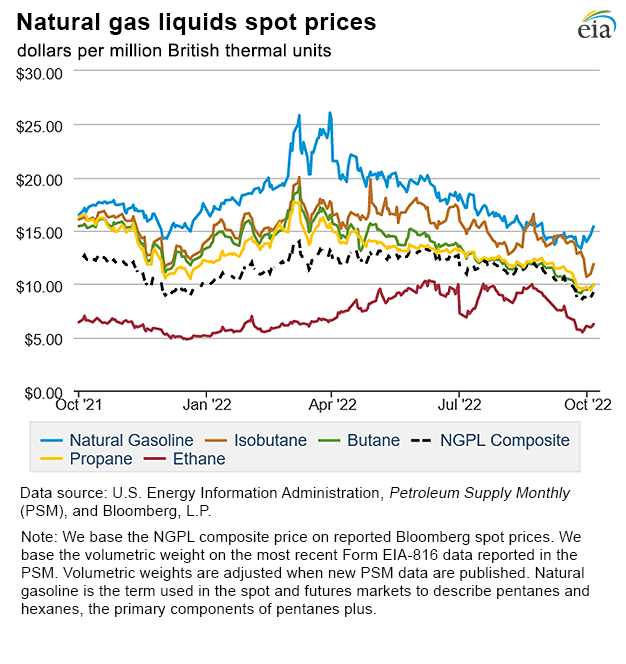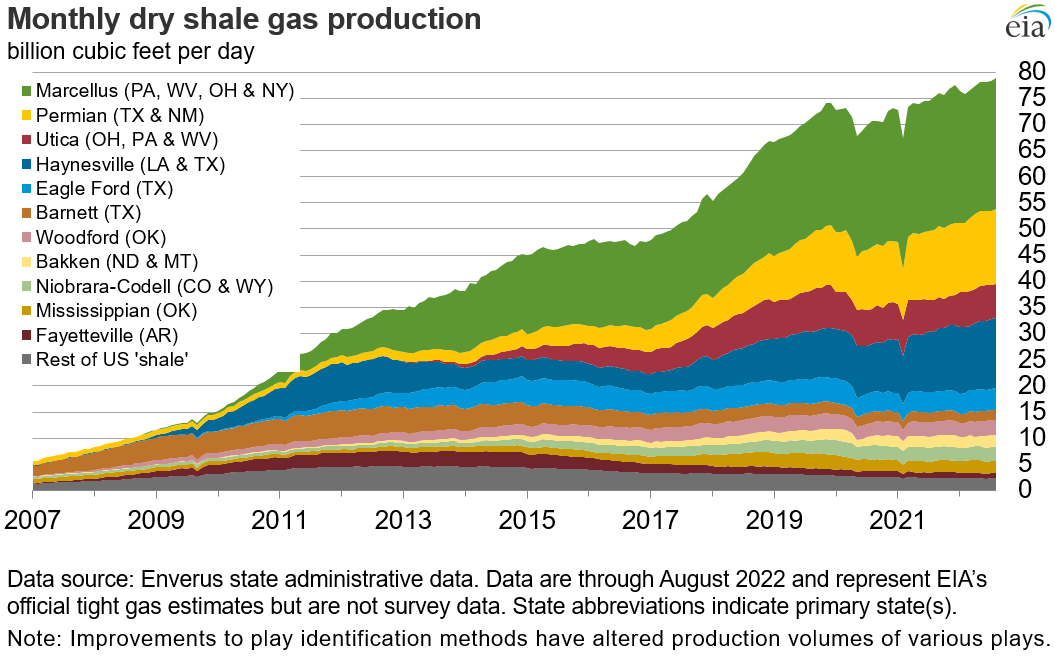In the News:
Larger-than-normal natural gas storage injections in September improved working gas stocks ahead of winter
Injections into U.S. working natural gas storage in the Lower 48 states are increasing at the end of the 2022 injection season (April–October), ahead of winter. The largest injection in the 2022 season so far was 129 billion cubic feet (Bcf) for the week ending September 30, which is the fourth net injection greater than 100 Bcf in 2022 and the second-highest net injection on record, 3 Bcf below the record injection of 132 Bcf in 2015, according to data from our Weekly Natural Gas Storage Report.
Total working natural gas stored in the Lower 48 states on September 30 was within the five-year historical range, totaling 3,106 Bcf, which is 8% below the five-year average of 3,370 Bcf. Storage levels at the beginning of refill season (April 1) were lower than the five-year average because of a mid-winter surge in demand followed by record-high electricity generation this summer, limiting natural gas injections. The late-season injections from the past three weeks have decreased the storage deficit from 11% on September 2 to 8% on September 30.
Through four full weeks in September, net injections into natural gas storage in the Lower 48 states averaged 103 Bcf, which is 22 Bcf higher than the five-year (2017–2021) average. Net injections exceeded 100 Bcf for the last three weeks in September.
The large net injection at the end of the month was, in part, a result of more production and less demand following cooler temperatures and energy disruptions brought about by Hurricane Ian. When the storm made landfall on the southwest Florida coast on September 29, 2.6 million Floridians’ homes and businesses were without power. For the week ending September 30, the South Central region almost doubled its injections from the previous week, totaling 45 Bcf.
In 2014 and 2019, net injections into natural gas storage in the Lower 48 states were greater than or equal to 100 Bcf for 10 weeks. In these years, the U.S. also started the refill season with low natural gas inventory and relatively high natural gas production. This September, daily U.S. dry natural gas production has exceeded 100 Bcf/d on seven days, according to data from PointLogic.
Based on data from EIA and PointLogic, dry natural gas production during the 2022 injection season has been higher than in any other refill season on record, and 3.9 billion cubic feet per day (Bcf/d), or 4.2%, higher than the 2021 season average.
Trends in temperatures and possible storms in October will play key roles in determining end-of-season working gas levels. For the past two years, October has had above-normal temperatures leading to more injections into storage. Currently, the National Oceanic and Atmospheric Administration (NOAA) forecasts that October will have above-normal temperatures after a cool start in most of the Lower 48 states, which could drive higher-than-normal balances into November as a result of decreased demand.
Market Highlights:
(For the week ending Wednesday, October 5, 2022)Prices
- Henry Hub spot price: The Henry Hub spot price fell 55 cents from $6.61 per million British thermal units (MMBtu) last Wednesday to $6.06/MMBtu yesterday.
- Henry Hub futures prices: The October 2022 NYMEX contract expired last Wednesday at $6.868/MMBtu. The November 2022 NYMEX contract price decreased to $6.930/MMBtu, down 3 cents from last Wednesday to yesterday. The price of the 12-month strip averaging November 2022 through October 2023 futures contracts climbed 9 cents to $5.830/MMBtu.
- Select regional spot prices: Natural gas spot prices rose at most locations this report week (Wednesday, September 28, to Wednesday, October 5). Week-over-week increases at major pricing hubs ranged from $0.64 at PG&E Citygate in northern California to $1.36 at Malin at the California-Oregon border, while the price at the Waha Hub in western Texas decreased by $0.61, and the price at the Henry Hub in southern Louisiana decreased by $0.55.
- In the Southeast, the Florida Gas Transmission (FGT) Citygate spot price, which reflects deliveries into Florida via the FGT pipeline, fell slightly, by 6 cents, from $6.87/MMBtu last Wednesday to $6.81/MMBtu yesterday. Natural gas consumption in the electric power sector in the Southeast declined by 16%, or 1.6 billion cubic feet per day (Bcf/d) week over week, according to data from PointLogic. Over 200,000 homes and businesses remain without power in Florida following Hurricane Ian, according to the Hurricane Ian DOE Situation Report Update 17. At the peak, 2.7 million customers in Florida were without power, according to the report.
- In the Northeast, at the Algonquin Citygate, which serves Boston-area consumers, the price increased 84 cents from $5.19/MMBtu last Wednesday to $6.03/MMBtu yesterday. At the Transcontinental Pipeline Zone 6 trading point for New York City, the price increased $1.19 from $4.78/MMBtu last Wednesday to $5.97/MMBtu yesterday. In the Appalachia region, the Tennessee Zone 4 Marcellus spot price increased $1.14 from $4.63/MMBtu last Wednesday to $5.77/MMBtu yesterday, and the price at Eastern Gas South in southwest Pennsylvania rose 92 cents from $4.75/MMBtu last Wednesday to $5.67/MMBtu yesterday. Temperatures in the Northeast region were below normal this week. In the Boston Area, temperatures averaged 55°F, or 4°F lower than normal, leading to 66 heating degree days (HDD), which is 44 more HDDs than last report week. Similarly, in the New York Central Park Area, temperatures averaged 55°F, leading to 69 HDDs, which is 51 more HDDs than last report week. Across the Northeast region, natural gas consumption in the residential and commercial sectors increased by 46% (1.8 Bcf/d) this report week, according to data from PointLogic.
- The price at the Waha Hub, which is located near Permian Basin production activities in West Texas, fell 61 cents this report week, from $3.94/MMBtu last Wednesday to $3.33/MMBtu yesterday, the lowest price among major pricing hubs. El Paso Natural Gas (EPNG) has cut westbound flows by over 300 million cubic feet per day (MMcf/d) on the southern part of its system (from Main Line valve 26 in El Paso County on the Texas-New Mexico border) due to maintenance that started on October 3 and is expected to continue until October 21. EPNG also announced a 300 MMcf/d cut in westbound flows along the northern part of its system due to a force majeure event on Line 1300 near Gallup on the New Mexico-Arizona border on October 4. Maintenance will likely last until October 24. Natural gas consumption in the electric power sector in Texas decreased by 29% (1.6 Bcf/d) week over week, according to data from PointLogic, as temperatures across Texas fell this week, leading to fewer cooling degree days (CDD). In the Houston Area, temperatures averaged 72°F, leading to 49 CDDs, 62 fewer than last report week. Similarly, in the Dallas-Fort Worth Area, temperatures averaged 71°F, leading to 47 CDDs, 69 fewer than last report week. As well as lower demand in Texas, natural gas pipeline exports to Mexico from Texas declined by 2% (0.1 Bcf/d) week over week, to 5.3 Bcf/d.
- International futures prices: International natural gas futures prices declined this report week. According to Bloomberg Finance, L.P., weekly average futures prices for liquefied natural gas (LNG) cargoes in East Asia decreased $1.78 to a weekly average of $37.99/MMBtu, and natural gas futures for delivery at the Title Transfer Facility (TTF) in the Netherlands, the most liquid natural gas market in Europe, decreased $2.45 to a weekly average of $51.00/MMBtu.
- Natural gas plant liquids prices: The natural gas plant liquids composite price at Mont Belvieu, Texas, rose by 6 cents/MMBtu, averaging $8.90/MMBtu for the week ending October 5. The average weekly price of ethane rose 5%, while the natural gas price at the Houston Ship Channel fell 12%. Ethane moved to a $1.06/MMBtu premium to natural gas this report week, compared with an 11 cents/MMBtu discount for the week ending September 28. The price of ethylene fell 8%, narrowing the ethylene to ethane premium by 24%. The natural gasoline price rose 5%, following the price of Brent crude oil, which rose 4%. The propane price fell 1%, widening the propane discount to crude oil by 14%. The normal butane price rose 2%, while the isobutane price fell 13%.
Daily spot prices by region are available on the EIA website.
Supply and Demand
- Supply: According to data from PointLogic, the average total supply of natural gas rose by 0.7% (0.8 Bcf/d) compared with the previous report week. Dry natural gas production grew by 0.9% (0.9 Bcf/d) week over week to reach the highest weekly average on record of 100.3 Bcf/d this report week. Average net imports from Canada decreased by 1.4% (0.1 Bcf/d) from last week.
- Demand: Total U.S. consumption of natural gas fell by 1.2% (0.8 Bcf/d) compared with the previous report week, according to data from PointLogic. Natural gas consumed for power generation declined by 9.3% (3.0 Bcf/d) week over week, the result of lower air-conditioning demand, as seasonal trends switch from cooling to heating demand. Industrial sector consumption increased by 1.6% (0.4 Bcf/d), and in the combined residential and commercial sectors, consumption increased by 16.2% (1.9 Bcf/d). Natural gas exports to Mexico decreased 3.5% (0.2 Bcf/d), while natural gas deliveries to U.S. LNG export facilities (LNG pipeline receipts) averaged 11.3 Bcf/d, or 0.3 Bcf/d lower than last week.
Liquefied Natural Gas (LNG)
- Pipeline receipts: Natural gas deliveries to LNG export terminals in South Louisiana increased 3% (0.2 Bcf/d) to 8.4 Bcf/d this report week, while deliveries to terminals in South Texas were relatively flat at 2.4 Bcf/d. Natural gas deliveries to the Cove Point terminal in Maryland fell 71% (0.5 Bcf/d) week over week to a weekly rate of 0.2 Bcf/d, as the terminal began annual planned maintenance activities on October 1. Maintenance is scheduled through October 18, according to an informational posting. Natural gas deliveries to other LNG export terminals were relatively flat week over week. Overall, natural gas deliveries to U.S. LNG export terminals averaged 11.3 Bcf/d this report week, which is 3% (0.3 Bcf/d) less than last report week.
- Vessels departing U.S. ports: Twenty LNG vessels (seven from Sabine Pass, four each from Calcasieu Pass and Corpus Christi, three from Cameron, and one each from Cove Point and Elba Island) with a combined LNG-carrying capacity of 75 Bcf departed the United States between September 29 and October 5, according to shipping data provided by Bloomberg Finance, L.P.
Rig Count
- According to Baker Hughes, for the week ending Tuesday, September 27, the natural gas rig count decreased by 1 rig from a week ago to 159 rigs. The Marcellus added three rigs, the Arkoma Woodford dropped three rigs, and the Utica dropped one rig. The number of oil-directed rigs increased by 2 rigs from a week ago to 604 rigs. The Ardmore Woodford, the Cana Woodford, and an unidentified producing region each added one rig, and the Mississippian dropped one rig. The total rig count, which includes 2 miscellaneous rigs, now stands at 765 rigs, which is 237 more than the same week last year.
Storage
- The net injections into storage totaled 129 Bcf for the week ending September 30, compared with the five-year (2017–2021) average net injections of 87 Bcf and last year's net injections of 114 Bcf during the same week. Working natural gas stocks totaled 3,106 Bcf, which is 264 Bcf (8%) lower than the five-year average and 165 Bcf (5%) lower than last year at this time.
- According to The Desk survey of natural gas analysts, estimates of the weekly net change to working natural gas stocks ranged from net injections of 95 Bcf to 131 Bcf, with a median estimate of 121 Bcf.
- The average rate of injections into storage is 1% higher than the five-year average so far in the refill season (April through October). If the rate of injections into storage matched the five-year average of 8.9 Bcf/d for the remainder of the refill season, the total inventory would be 3,381 Bcf on October 31, which is 264 Bcf lower than the five-year average of 3,645 Bcf for that time of year.
See also:
Top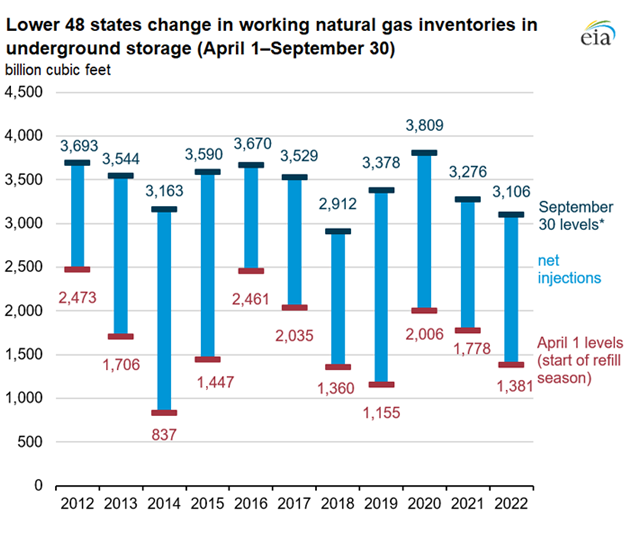 Data source: U.S. Energy Information Administration, Natural Gas Monthly and Weekly Natural Gas Storage Report (*used for the September 30, 2022 data point)
Data source: U.S. Energy Information Administration, Natural Gas Monthly and Weekly Natural Gas Storage Report (*used for the September 30, 2022 data point)
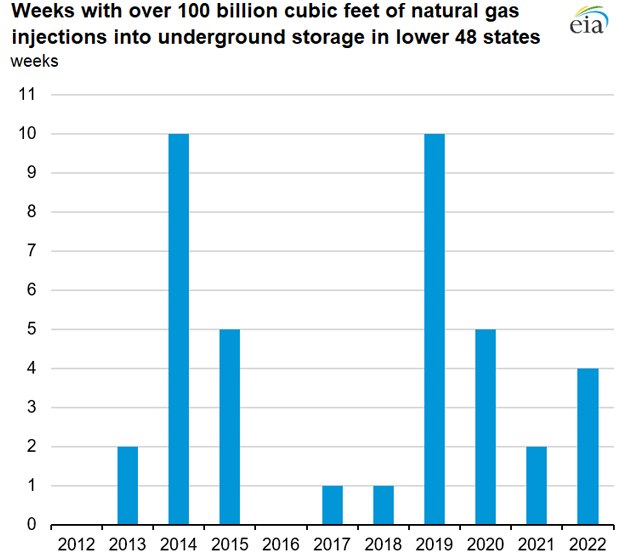
Data source: U.S. Energy Information Administration, Weekly Natural Gas Storage Report
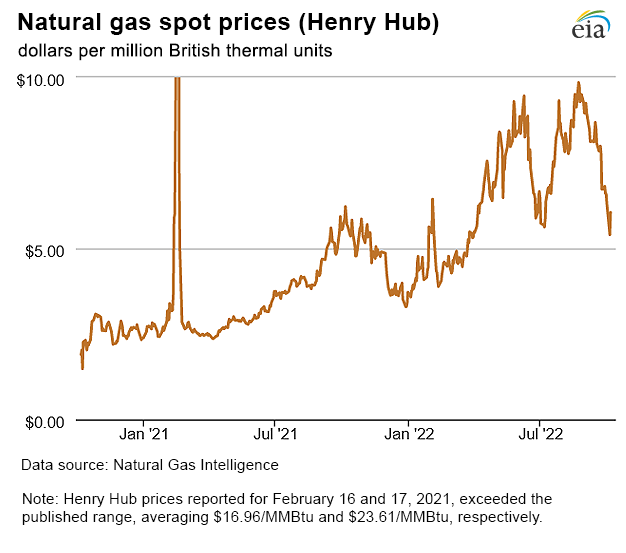
| Spot Prices ($/MMBtu) | Thu, 29-Sep |
Fri, 30-Sep |
Mon, 03-Oct |
Tue, 04-Oct |
Wed, 05-Oct |
|---|---|---|---|---|---|
| Henry Hub |
6.59 |
6.29 |
5.64 |
5.40 |
6.06 |
| New York |
4.50 |
4.11 |
4.95 |
5.27 |
5.97 |
| Chicago |
5.06 |
4.55 |
4.74 |
5.24 |
6.17 |
| Cal. Comp. Avg.* |
5.81 |
5.47 |
5.55 |
6.27 |
7.26 |
| Futures ($/MMBtu) | |||||
| November contract | 6.874 |
6.766 |
6.470 |
6.837 |
6.930 |
| December contract |
7.142 |
7.065 |
6.803 |
7.174 |
7.236 |
| Data source: Natural Gas Intelligence and CME Group as compiled by Bloomberg, L.P. *Avg. of NGI's reported prices for: Malin, PG&E Citygate, and Southern California Border Avg. |
|||||
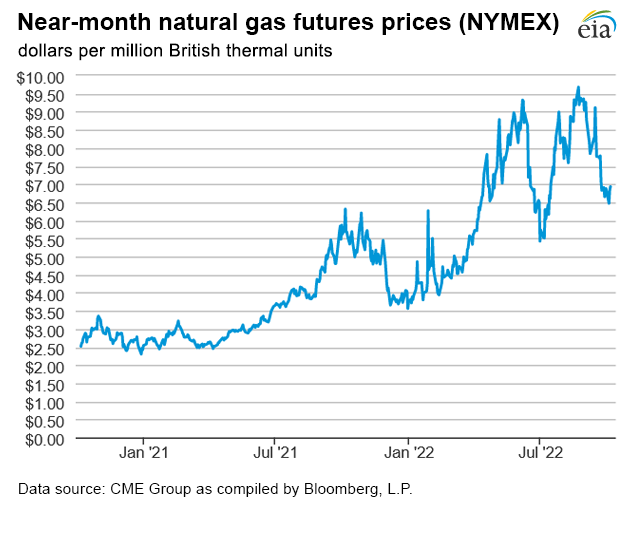
| U.S. natural gas supply - Gas Week: (9/29/22 - 10/5/22) | |||
|---|---|---|---|
Average daily values (billion cubic feet) |
|||
this week |
last week |
last year |
|
| Marketed production | 112.6 |
111.5 |
105.2 |
| Dry production | 100.3 |
99.4 |
94.9 |
| Net Canada imports | 6.1 |
6.2 |
5.3 |
| LNG pipeline deliveries | 0.1 |
0.1 |
0.1 |
| Total supply | 106.5 |
105.7 |
100.3 |
|
Data source: PointLogic | |||
| U.S. natural gas consumption - Gas Week: (9/29/22 - 10/5/22) | |||
|---|---|---|---|
Average daily values (billion cubic feet) |
|||
this week |
last week |
last year |
|
| U.S. consumption | 66.0 |
66.8 |
62.5 |
| Power | 29.7 |
32.8 |
32.1 |
| Industrial | 22.6 |
22.2 |
21.4 |
| Residential/commercial | 13.7 |
11.8 |
9.0 |
| Mexico exports | 5.8 |
6.0 |
5.5 |
| Pipeline fuel use/losses | 6.6 |
6.6 |
6.2 |
| LNG pipeline receipts | 11.3 |
11.6 |
10.3 |
| Total demand | 89.7 |
91.0 |
84.5 |
|
Data source: PointLogic | |||
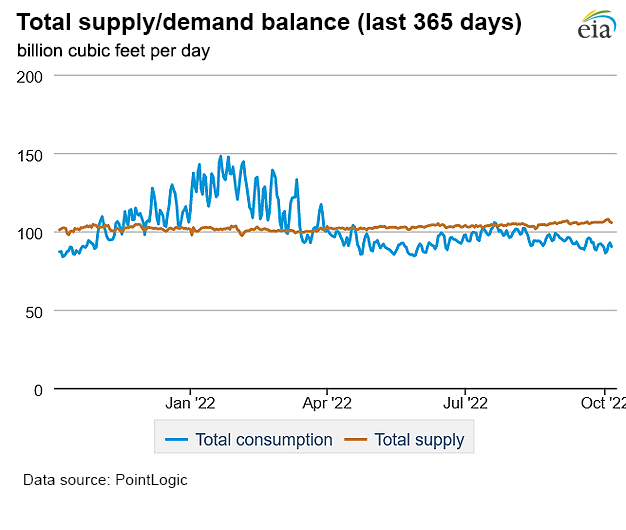
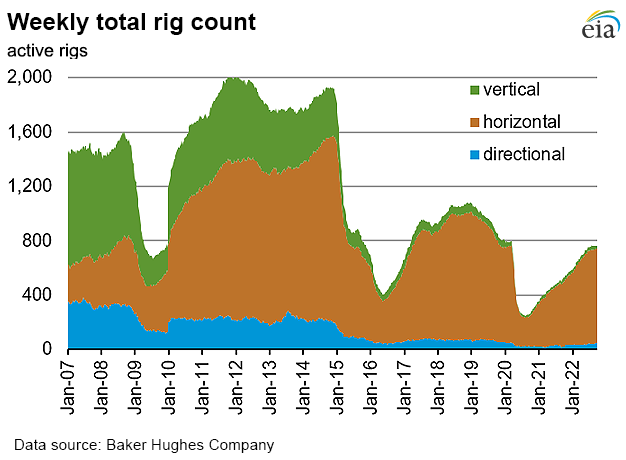
| Rigs | |||
|---|---|---|---|
Tue, September 27, 2022 |
Change from |
||
last week |
last year |
||
| Oil rigs | 604 |
0.3% |
41.1% |
| Natural gas rigs | 159 |
-0.6% |
60.6% |
| Note: Excludes any miscellaneous rigs | |||
| Rig numbers by type | |||
|---|---|---|---|
Tue, September 27, 2022 |
Change from |
||
last week |
last year |
||
| Vertical | 23 |
-8.0% |
-28.1% |
| Horizontal | 696 |
0.4% |
46.8% |
| Directional | 46 |
0.0% |
109.1% |
| Data source: Baker Hughes Company | |||
| Working gas in underground storage | ||||
|---|---|---|---|---|
Stocks billion cubic feet (Bcf) |
||||
| Region | 2022-09-30 |
2022-09-23 |
change |
|
| East | 756 |
721 |
35 |
|
| Midwest | 916 |
879 |
37 |
|
| Mountain | 184 |
176 |
8 |
|
| Pacific | 247 |
243 |
4 |
|
| South Central | 1,003 |
958 |
45 |
|
| Total | 3,106 |
2,977 |
129 |
|
| Data source: U.S. Energy Information Administration Form EIA-912, Weekly Underground Natural Gas Storage Report | ||||
| Working gas in underground storage | |||||
|---|---|---|---|---|---|
Historical comparisons |
|||||
Year ago (9/30/21) |
5-year average (2017-2021) |
||||
| Region | Stocks (Bcf) |
% change |
Stocks (Bcf) |
% change |
|
| East | 806 |
-6.2 |
833 |
-9.2 |
|
| Midwest | 966 |
-5.2 |
970 |
-5.6 |
|
| Mountain | 205 |
-10.2 |
208 |
-11.5 |
|
| Pacific | 247 |
0.0 |
286 |
-13.6 |
|
| South Central | 1,048 |
-4.3 |
1,074 |
-6.6 |
|
| Total | 3,271 |
-5.0 |
3,370 |
-7.8 |
|
| Data source: U.S. Energy Information Administration Form EIA-912, Weekly Underground Natural Gas Storage Report | |||||
| Temperature – heating & cooling degree days (week ending Sep 29) | ||||||||
|---|---|---|---|---|---|---|---|---|
HDDs |
CDDs |
|||||||
| Region | Current total |
Deviation from normal |
Deviation from last year |
Current total |
Deviation from normal |
Deviation from last year |
||
| New England | 56 |
2 |
35 |
0 |
-1 |
-12 |
||
| Middle Atlantic | 50 |
7 |
31 |
0 |
-5 |
-6 |
||
| E N Central | 74 |
28 |
43 |
0 |
-6 |
-8 |
||
| W N Central | 58 |
11 |
34 |
5 |
-5 |
-17 |
||
| South Atlantic | 29 |
11 |
15 |
37 |
-10 |
-8 |
||
| E S Central | 30 |
13 |
10 |
23 |
-10 |
-4 |
||
| W S Central | 2 |
-2 |
-1 |
74 |
13 |
16 |
||
| Mountain | 21 |
-30 |
-4 |
39 |
11 |
15 |
||
| Pacific | 3 |
-13 |
-8 |
48 |
27 |
32 |
||
| United States | 39 |
6 |
19 |
27 |
2 |
2 |
||
|
Data source: National Oceanic and Atmospheric Administration Note: HDDs=heating degree days; CDDs=cooling degree days | ||||||||
Average temperature (°F)
7-day mean ending Sep 29, 2022
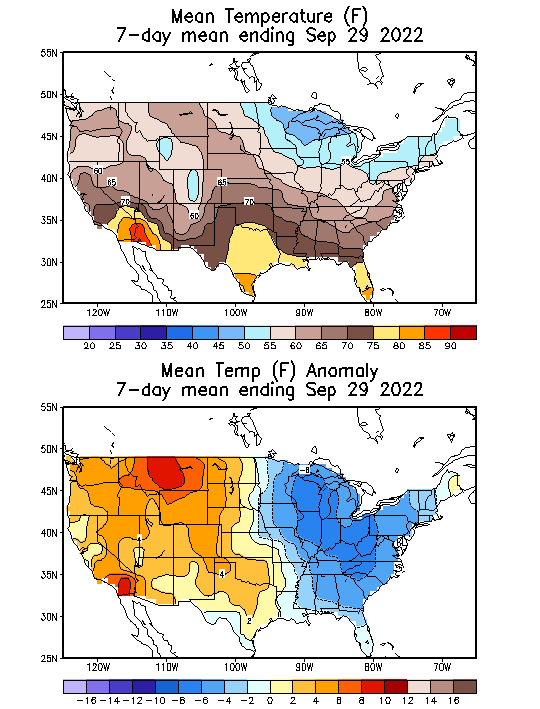
Data source: National Oceanic and Atmospheric Administration
Deviation between average and normal temperature (°F)
7-day mean ending Sep 29, 2022

Data source: National Oceanic and Atmospheric Administration

